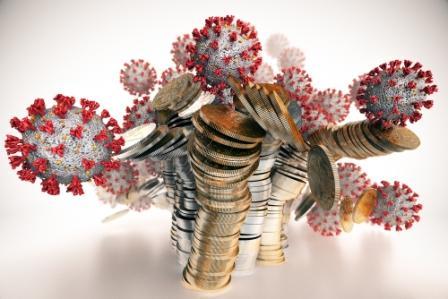
The global economy is passing through an unprecedented phase fighting the Covid-19 pandemic. Not only health, but the economic cost associated with the pandemic is high. As per the IMF, the global economy is dealing with the worst recession since the Great Depression of the 1930s. The estimates put the global GDP growth rate at -3 percent for CY20. Against this background, countries across the globe have announced various fiscal as well as monetary stimulus packages as support to their respective economies. For instance, the US government announced a fiscal stimulus package of $ 2 trillion, which is around 10 percent of the US GDP. Similarly, in India, the Government announced a fiscal package of Rs 1.7 trillion.
The Great Lockdown recession is bringing in huge pressure on government exchequers. In India, the fiscal pressure is already high as the economy has been passing through a phase of economic slowdown. In this background, the cost associated with the spread of Covid-19 is adding more strain to the government finances. Coming to the receipt budget of the Central government, tax revenue holds a share of around 80 percent of the total revenue receipts. For FY21, the government has set a target of Rs 16.3 lakh crore for the tax revenue, with a growth rate of 8 percent from the previous fiscal year.
Slowdown in Economic Activities
Tax revenue generation in any economy depends on how well the economy is performing and the economic activities taking place. In the current scenario, amid the lockdown and an uncertain atmosphere, it is well-factored that economic activities in the country are badly hit.
Of the Gross Value Added (GVA), the service sector holds a share of around 55 percent. Within the service sector, travel, hotels, transport, communication and services related to broadcasting has a share of 18 percent of the total GVA. However, the travel and tourism industry are badly hit from the current crisis, and there is an uncertainty on when these sectors will resume their normal operation. The scenario is not much different for the manufacturing sector with various factories in shutdown. The agriculture sector is also facing the heat due to the non-availability of labourers.
Strain on Receipts
Within the tax revenue, GST has the highest share followed by Corporation tax and taxes on income. GST collection reflects the state of the economic activities in the country, and it declined to Rs 97,597 crore in March against Rs 1.05 lakh crore collected in February.For April, the opening month of FY21, GST collection would be much lower as the domestic economy is in a complete lockdown till 3rd May. The declining trend will continue in the coming months also. A similar trend will be visible in the case of corporation tax and taxes on income.Corporation tax and income tax depends on the profit/income growth of companies and individuals, which in turn is linked to the economic activities.
Considering a nominal GDP growth rate of 10 percent, the target for tax revenue was set at Rs 16.3 lakh crore. However, the IMF has downgraded India’s GDP growth rate to 1.9 percent and taking the inflation rate at 4 percent, India’s nominal GDP growth rate would fall to 6 percent. In such a scenario, tax revenue growth would be much lower than the target that is being budgeted.
For non-tax revenue, the target is set at Rs 3.8 lakh crore for FY21. The major component of non-tax revenue is dividends and profits. Considering the Open Market Operations (OMO) conducted by the RBI in FY20, it is expected that the Government will gain from the dividend transfer by the Central Bank. RBI has transferred Rs 1.23 lakh crore as annual dividend to the Government in the last fiscal, on the wake of large amount of OMOs conducted by the RBI in FY19.
Similarly, the disinvestment target, the major component of capital receipts, set at Rs 2.1 lakh crore will also be difficult to achieve. The poor state of the stock market makes it difficult for the government to realise the disinvestment receipts. Similarly, in the present scenario, considering the weak health of the aviation sector, it would be difficult to get a potential buyer for Air India. In brief, the Government is going to face severe revenue crunch in the current fiscal year. The situation is similar or much worse for the states also.
In the present scenario, it is not possible for the Government to cut down its expenditure. As the economy is passing through a difficult phase, various stakeholders are expecting more support from the government. It is well-factored that the government won’t be able to achieve the fiscal deficit target for FY20 and FY21. To meet the increased spending, the Government will be forced to borrow from the market. Increased market borrowing from the state governments are also expected in the current fiscal year. Talks are also going on the need to monetise a part of the deficit of the government. However, a final decision in this regard should be taken only after much deliberation as it can have other negative repercussions on the economy.










Local self goverments revenue will decline and expenditures will increase